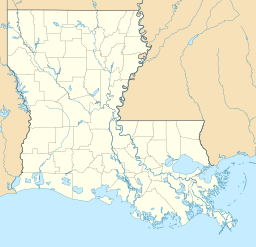Lake St. Catherine (Louisiana) facts for kids
Quick facts for kids Lake St. Catherine |
|
|---|---|
| Location | New Orleans, Louisiana |
| Coordinates | 30°07′43″N 89°44′19″W / 30.12861°N 89.73861°W |
| Type | brackish water |
| Primary inflows | Fort Pike Canal, Sawmill Pass, Marques Canal, Unknown Pass, Miller's Ditch, Catherine Pass and Counterfit Pass |
| Basin countries | United States |
| Islands | New Orleans East Land Bridge |
Lake St. Catherine (also known as Lac Sainte-Catherine in French) is a special kind of lake in Louisiana. It's located in eastern Orleans Parish, right inside the city of New Orleans. This lake sits between two other big lakes, Lake Pontchartrain and Lake Borgne.
Lake St. Catherine has brackish water. This means it's a mix of fresh water and salt water. Long ago, a small town called Lake Catherine was built near here. It was a home for people who worked on the railroad, and for those who loved to trap, hunt, and fish.
Contents
History of Lake Catherine Town
A small town called Lake Catherine once stood between Lake St. Catherine and Lake Borgne. It was built near areas known as Unknown Pass and Miller's Ditch. This town was important for railroad workers, as well as people who hunted, fished, and trapped animals.
The 1915 Hurricane
In 1915, a powerful hurricane hit New Orleans. It completely destroyed the town of Lake Catherine. Sadly, many people who stayed in the town during the storm lost their lives.
After the hurricane, the town was rebuilt. Many hunting and fishing clubs were started there. The Rigolets Train Station also became a key spot. During the Great Depression, clubs like the Winchester Club became places where families and sportsmen could stay. They would come to hunt and fish in the area.
Before Hurricane Katrina in 2005, many families owned camps in this area. Some of their family members even worked for the railroad, helping to keep the train lines in good shape. The town was built right next to the railroad tracks. The last known person to live in the town was Mr. Acy. The entire area was badly damaged during Hurricane Katrina.
New Orleans East Land Bridge
To the north of Lake St. Catherine, there is a long, narrow piece of land called the New Orleans East Land Bridge. This "land bridge" is about nine miles (14 km) long and sits between Lake St. Catherine and Lake Pontchartrain.
Since the 1920s, many people have lived on this land bridge. It had several marinas, which are places for boats, along with taverns, restaurants, and boat repair shops. Before Hurricane Katrina, about 754 people lived there full-time. But on holidays like Labor Day weekend, the population could grow to two or three thousand people! Friends and family would gather for one last big weekend before winter.
The New Orleans East Land Bridge is made up of five different neighborhoods. These include the Rigolets, Chef Pass, Greens Ditch, Lake St. Catherine, and Fort Pike Subdivision. All of these areas are located along Highway 90 in New Orleans East.
Geography and Wildlife
Lake St. Catherine is a shallow lake. Several waterways flow into it, bringing water from different areas. These include Fort Pike Canal, Sawmill Pass, Marques Canal, Unknown Pass, Miller's Pass, St. Catherine Pass, and Counterfeit Pass.
The lake is a great spot for fishing. You can catch both freshwater and saltwater fish here. It's also full of crabs, clams, and shrimp. The smaller ponds connected to the main lake are perfect for hunting ducks and geese during the hunting season.
Hurricane Katrina's Impact
Hurricane Katrina hit the area in 2005. Most people had left before the storm, which saved many lives. However, two people sadly died during the hurricane.
One person was Father Arthur Ginart, also known as "Father Red." He chose to stay in his church, St. Nicholas of Myra, which was near Chef Menteur Pass. It is believed he drowned inside the church. The strong storm surge then washed him out to sea. The church building was badly damaged, but it reopened in 2014.
The second person who died was Wayne Aaslestad. He decided to stay at his home. Later, he was found in his car in Lake Pontchartrain. It is thought that he tried to leave too late.




